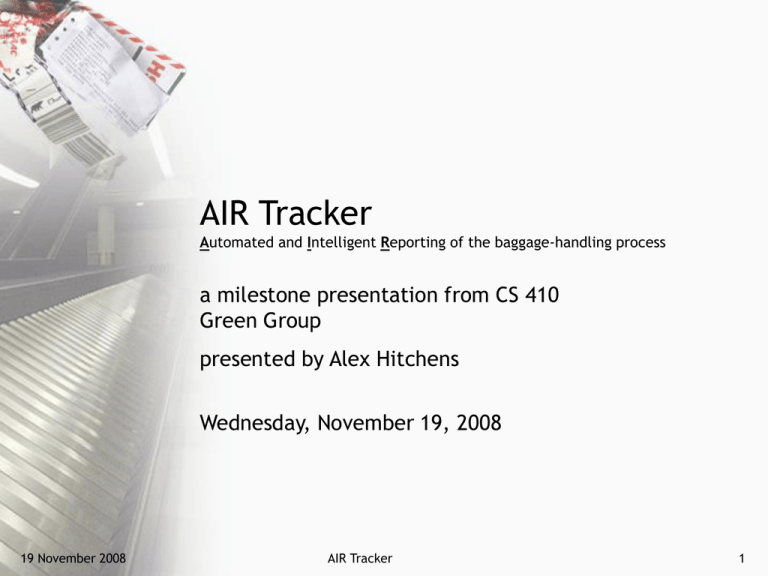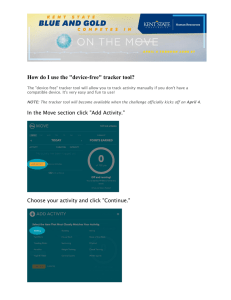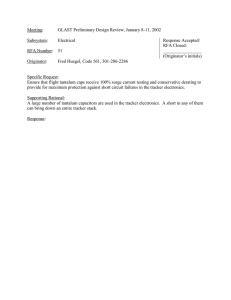AIR Tracker
advertisement

AIR Tracker Automated and Intelligent Reporting of the baggage-handling process a milestone presentation from CS 410 Green Group presented by Alex Hitchens Wednesday, November 19, 2008 19 November 2008 AIR Tracker 1 Organizational Chart 19 November 2008 AIR Tracker 2 Overview Problem Description Solution Description Process Description Solution Characteristics Management Plan Evaluation Plan Marketing Plan Funding Plan Risk Management Plan Competition Analysis Staffing Plan Milestones and Deliverables Conclusion 19 November 2008 AIR Tracker 3 Lonely Bag Dropped from Cart 19 November 2008 AIR Tracker 4 And Where Do These Bags Go? 19 November 2008 AIR Tracker 5 Has This Ever Happened to You? John is flying from Los Angeles to a very important client meeting in Norfolk. His self-made business hinges on the success of this sale, and he has a lot of equipment to bring. Federal regulations limit the number of bags he can carry on the plane with him. He must check two of them. Upon reaching Norfolk, John heads to the luggage carousel to wait for his bags, but they never come. John proceeds to talk with the personnel at the luggage claim office and has to fill out a form about the missing bags. 19 November 2008 AIR Tracker 6 What Happens Next? Scenario #1 - John is told that his bags are in Atlanta. - Perplexed, he asks how this could have happened. The airline assistant does not necessarily have an answer for him. - John will be unable to get his equipment in time for the meeting and risks canceling his business meeting. Scenario #2 - John is told that his bags are not showing up in the system. - Confused, he asks how this could have happened. The airline assistant does not have an answer for him. - John will possibly never see his equipment again and will have to cancel the entire trip’s business. 19 November 2008 AIR Tracker 7 An Expert’s Words “Baggage handlers drop more bags [off a cart] than they put baggage on the wrong flight.” “We’ll never know how many bags, when found to be missing from a flight, make it onto the right plane. Those statistics aren’t calculated.” “The carry-on versus checking issue is becoming more important because people are cheap. They refuse to check bags, but now, airlines can get fined thousands of dollars if a passenger carried more than two carryons onto a plane.” - Gloria Anderson, baggage handler at Norfolk International Airport 19 November 2008 AIR Tracker 8 Problem Description In spite of current quality assurance measures, airlines spend billions of dollars a year on mishandled luggage.1 This includes the funding to support the extra personnel to transport the bags to the individuals and also to reimburse travelers who’s bags have been lost. 1) Customer Relationship Management (CRM) Daily; in this case, “mishandled” means dropped, left behind, or mistakenly sent to the wrong area or plane. 19 November 2008 AIR Tracker 9 Solution Description The AIR Tracker software solution will augment existing systems at airports utilizing technology that already exists. Using the existing RFID antennae and bar code scanners that register the bag’s location, AIR Tracker will track and report on the routing of luggage in airports as well as offer a real-time account of luggage statistics on the luggage carts. AIR Tracker will utilize wireless and RFID technologies between carts and wireless access points that transfer that data back to the main database. 19 November 2008 AIR Tracker 10 Solution Characteristics AIR Tracker, by using existing technology at airports, will be customized for the layout of every airport. AIR Tracker will be an augmented reporting system for existing luggage routing mechanisms. AIR Tracker will provide comprehensive reports to assist the airport in pinpointing problem areas in their handling process, thereby reducing the amount of mishandled luggage. 19 November 2008 AIR Tracker 11 Facilitating the Tracking Process AIR Tracker will utilize existing technology, including bar codes, RFID tags, and databases, at airports in order to identify bags that have been dropped, identify bags that have been left behind, report on the overall baggage handling for each bag, and assist the airport in pinpointing trouble spots in current baggage handling processes. 19 November 2008 AIR Tracker 12 Process Before AIR Tracker 19 November 2008 AIR Tracker 13 Process Utilizing AIR Tracker 19 November 2008 AIR Tracker 14 AIR Tracker MFCD 19 November 2008 AIR Tracker 15 Plan Breakout 19 November 2008 AIR Tracker 16 Management Plan – The Team Since AIR Tracker is primarily a software solution, the team has put a heavy emphasis on this expertise. Each member will contribute to the project as a software specialist, thereby using all of the team’s collective skills in the programming process. The structure of the team includes each member having direct access to the project manager regarding his specific portion of the project. When the team moves on to Phase 1, a head programmer will be included and will interface between the project manager and the other programmers. 19 November 2008 AIR Tracker 17 Management Plan – Communication The AIR Tracker team meets three times a week (Monday, Wednesday, and Friday) from 1 p.m. to 4 p.m. The team uses this time for collaboration and to provide feedback on the work in individual areas. In addition to meeting times, the AIR Tracker team interacts via online forums. The team tracks its progress through milestones and a tasking list. 19 November 2008 AIR Tracker 18 Evaluation Plan AIR Tracker beta testing will begin at smaller airports, such as Norfolk International. Utilizing frequent fliers at first, the implementation will be gradual but consistent from the first day of testing. Of all fliers who have bags mishandled at airports, frequent fliers risk the most and would be the most efficient customers for airports to test. Each checkpoint at which a bag is scanned will be collected and kept in the AIR Tracker database. Generated reports will assist in analyzing problem areas in the baggage handling process. Preliminary analysis of the risks of beta testing include software issues. To prevent problems with the massive amount of data that the system may incur, careful design will be needed in addition to extensive testing before the beta tests. 19 November 2008 AIR Tracker 19 When We Will Know Success The cost of returning a mishandled bag to its owner, including fuel, manpower, and ground transportation costs, is estimated at around $90 by the International Air Transport Association.1 Airlines currently lose approximately seven bags per 1000. Southwest Airlines, for example, flies over 104 million passengers a year.2 That would conservatively equal approximately 728,000 mishandled bags a year, costing $65.5 million. If only three bags were lost per 1000, airlines would save almost $40 million. Saving one bag in 1000 saves almost $10 million. 1) MSNBC.com 2) Southwest.com 19 November 2008 AIR Tracker 20 Marketing Plan Since AIR Tracker is targeted at airports, the team will utilize personal marketing visits in order to market the product. Smaller airports will be used for beta testing. Success at these sites will entice larger airports to purchase AIR Tracker. Airports with an especially high rate of mishandled bags are a potential target market. 19 November 2008 AIR Tracker 21 Marketing Plan – Niche AIR Tracker easily integrates with existing systems. AIR Tracker customizes to fit the airport. AIR Tracker’s cart sensor gives additional feedback to baggage handlers at the site. 19 November 2008 AIR Tracker 22 Phase 1 Staff Costs Title Quantity Time Needed Hourly Rate Total Project Manager 1 640 hours $15 $9,600 Hardware Manager 1 320 hours $15 $4,800 Software Manager 2 520 hours $15 $15,600 Marketing Director 1 80 hours $15 $1,200 Financial Specialist 1 160 hours $15 $2,400 Webmaster 1 80 hours $15 $1,200 Wireless Consultant 1 30 hours $15 $1,050 Transportation Consultant 1 70 hours $15 $840 Database Analyst 1 400 hours $15 $6,000 $42,690 40% Overhead $17,080 Totals 19 November 2008 10 AIR Tracker 2,300 hours - $59,770 23 Phase 1 Resource Costs RFID receiver - $150 RFID tags - $10 ______________________________ Grand Total: $160 19 November 2008 AIR Tracker 24 Phase 2 Staff Costs Title Salary Time Needed Hourly Rate Total Project Manager $62,000 640 hours $30 $19,000 Hardware Manager $58,000 160 hours $28 $8,960 Software Manager $104,000 520 hours $50 $24,960 Marketing Director $82,000 80 hours $40 $3,200 Financial Specialist $45,000 160 hours $22 $3,520 Webmaster $64,000 80 hours $24 $1,840 Wireless Consultant $52,000 70 hours $25 $1,750 Transportation Consultant $24,000 70 hours $12 $840 Technical Writer $58,000 160 hours $28 $4,480 Outsourced Electrician $42,000 160 hours $21 $3,360 Database Administrator $80,000 80 hours $39 $3,120 $75,030 40% Overhead Totals 19 November 2008 - 2,180 hours AIR Tracker $30,010 - $105,040 25 Phase 2 Resource Costs RFID receiver - $150 Wireless antennae - $250 Portable scanners - $300 RFID tags - $10 Oracle 11g license - $10,000 Dell PowerEdge 2900 III - $15,000 ______________________________ Grand Total: $25,710 19 November 2008 AIR Tracker 26 Marketing Plan – Price Point Hardware + Software = $50,000 - Even if AIR Tracker only reduces mishandled bags by one bag per 1000, airports using AIR Tracker will find that the system pays for itself in the first year. - With an estimated cost of salaries and upkeep in Phase 3 nearing $900,000, the AIR Tracker team would need to sell 37 systems to begin seeing profit. 19 November 2008 AIR Tracker 27 Funding Plan Phase 1 – NSF SBIR Grant (up to $100,000) Phase 2 – NSF SBIR Grant (up to $750,000) Phase 3 – Federal Aviation Administration Grant - Airport Improvement Program (20.106) - $12,000 to $35 million - average grant: $1.25 million - Small Business Loans 19 November 2008 AIR Tracker 28 Risk Management Plan AIR Tracker’s main area of risk outside of poor marketing is wireless communications. Some installation of new equipment may be required. AIR Tracker’s signals may be affected by other signals. The implementation of several technologies on one device may pose a problem. Risk analysis and a detailed mitigation plan will aid in reducing AIR Tracker’s risk. 19 November 2008 AIR Tracker 29 Risk Analysis Initial Risks 2 1 3 4 5 1. 2. 3. 4. 5. Not Enough Airports Attracted Unintentional Personal Information Leak Incompatible Database Format Customers Unable to Install SW/HW Wireless Communication Problems Mitigation of Risks 1. Solid Marketing 2. Solid Database Security 3. Customized Database Queries and Extensive Research on Existing Databases 4. Extensive and In-Depth Training 5. In-Depth Research and Maximized Wireless Implementation 19 November 2008 AIR Tracker 30 Competition Analysis 19 November 2008 AIR Tracker 31 AIR Tracker Versus Competition Although the competition helps to solve each facet of the mishandled luggage problem, AIR Tracker supplements their capabilities. 1 1) Popular Mechanics 19 November 2008 AIR Tracker 32 Staffing Plan: Phase 0 Organization 19 November 2008 AIR Tracker 33 Staffing Plan: Phase 1 Organization 19 November 2008 AIR Tracker 34 Staffing Plan: Phase 2 Organization 19 November 2008 AIR Tracker 35 Staffing Plan: Phase 3 Organization 19 November 2008 AIR Tracker 36 Milestones 19 November 2008 AIR Tracker 37 Deliverables Phase 0 (Product Conception) Feasiblity, Milestone, Final, SBIR, Website Phase 1 (Proof of Concept) Creative, Descriptive, Technical, Budget, and User Papers; Design Prototype; Develop Prototype; Market and Survey Research; Website; SBIR (Part 2) Phase 2 (Working Production Model Development) Management Plan, Product Design Specifications, Testing and Evaluation Plan, Working Production Model, Market Plan and Contracts Phase 3 (Production) Consumer Acceptance and Requirements, Sales Contracts, Maintenance and Support Handling, Product Documentation, Product Release 19 November 2008 AIR Tracker 38 Conclusion Mishandled luggage costs unnecessary resources, including money, time, and personnel. The process in place has inherent flaws, and in order to locate these areas and provide the most efficient operations and customer service, AIR Tracker should and must be employed. 19 November 2008 AIR Tracker 39 References 1) 2) 3) 4) 5) 6) 7) 8) 9) 19 November 2008 “Air Travel Consumer Reports for 2008.” airconsumer.ost.dot.gov. 30 JUL 2008. Office of Aviation Enforcement. 01 Oct 2008 <http://airconsume r.ost.dot.gov/reports/atcr08.htm>. “Airport IT Trends Survey 2008.” sita.aero. SITA. 21 Oct 2008 <http://www .sita.aero/News_Centre/Industry_surveys_and_trends/Airport_IT_trends /default.htm>. Bevan, Judi. “Coping with crisis, climate change — and lost luggage.” spectator.co.uk. 07 Nov 2007. The Spectator. 20 Oct 2008 <http://ww w.spectator.co.uk/the-magazine/business/334921/coping-with-crisis-cli mate-change-and-lost-luggage.html>. Bicknell, David. “Airlines reject RFID as universal industry solution to lost bags.” ComputerWeekly.com. 30 Jul 2008. Computer Weekly. 20 Oct 2008 <http://www.computerweekly.com/Articles/2008/06/20/2311 41/airlines-reject-rfid-as-universal-industry-solution-to-lost.htm>. “Frequently Asked Questions.” globalbagtag.com. Global Bag Tag. 20 Oct 2008 <http://www.globalbagtag.com/faq.cfm>. Halthore, Mukund. “RE: Contact request from website (Germany).” Email to Joel Elixson concerning the wholesale cost of GPS/GSM modules. 21 Oct 2008. “IBM System x3450.” IBM. 2008. IBM. 21 Oct 2008 <http://www-304.ibm.co m/shop/americas/webapp/wcs/stores/servlet/default/CategoryDisplay ?categoryId=4611686018425232005&storeId=1&catalogId=-840&langId= 1>. James, Andrea. “Seattle firm sues British Airways over lost luggage.” Seattle PI. 13 Nov 2007. Seattle PI. 21 Oct 2008 <http://seattlepi.nwso urce.com/business/339434_lostluggage13.html>. “Job Salaries-Performance Reviews-Compensation software- Salary.com.” 2008. Salary.com. 04 Nov 2008 <http://www.salary.com>. AIR Tracker 40 References 10) Levy, Francesca. “The Airlines’ Bag Reflex.” BusinessWeek.com. 30 Jul 2008. Business Week. 20 Oct 2008 <http://www.businessweek.com/life style/content/jul2008/bw20080729_355085.htm>. 11) Mummolo, Jonathan. “Now Arriving At Carousel 1, Far Fewer Of Your Bags.” Washingtonpost.com. 01 Oct 2007. Washington Post. 20 Oct 20 08 <http://www.washingtonpost.com/wpdyn/content/article/2007/09 /30/AR2007093001653.html?sid=ST2007100200809>. 12) Scottberg, Erin. “Anatomy of Lost Luggage: How to Track Your Bags (and Save ’Em).” Popular Mechanics. 20 Dec 2007. Popular Mechanics. 21 Oct 2008 <http://www.popularmechanics.com/technolo gy/transportation/4237628.html>. 13) “Software Engineer / Developer / Programmer Job Salaries in Virginia Beach-Norfolk-Newport News, VA-NC.” PayScale. 2008. 21 Oct 2008 <http://www.payscale.com/af/calc.aspx?job=program mer&city=Norfo lk&state=VA>. 14) “IB Technology 125 kHz RFID Antenna.” Trossen Robotics. 2008. Trossen Robotics. 04 Nov 2008 <http://www.trossenrobotics.com/ib-technology125-khz-rfid-antenna.aspx?feed=Froogle>. 19 November 2008 AIR Tracker 41 Questions? 19 November 2008 AIR Tracker 42

